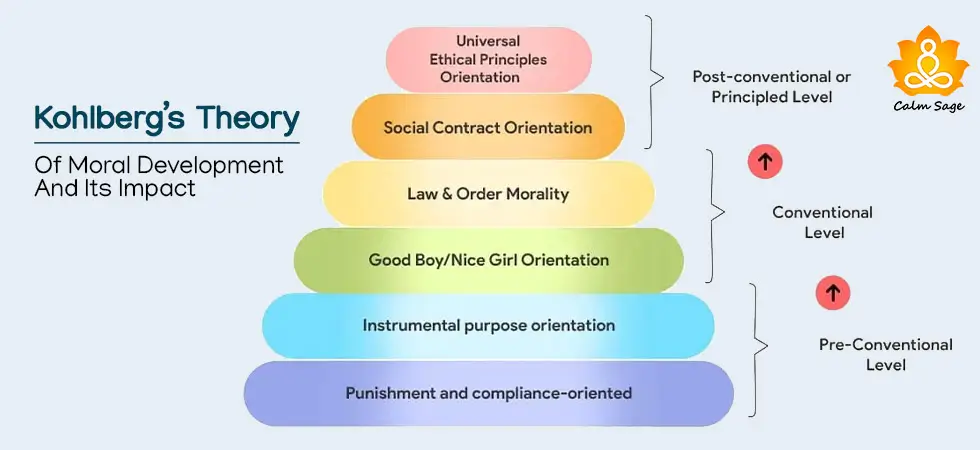Kohlberg’s Theory Of Moral Development And Its Impact

Have you ever wondered how moral reasoning develops in an individual? How do people differentiate between right and wrong? How is an action justifiable for some and completely unacceptable for others? Well, Kohlberg, through his theory, explains moral development. The theory extends Jean Piaget’s cognitive development theory, focusing on moral logic and maintaining justice. There are six stages in which an individual develops an understanding of morality and implements it in life.
What is Moral Development?
It is a procedure through which individuals learn to differentiate between what should and should not be done and why. But the question is, how does this develop? Is it the parents or society that influences it? Do all kids develop this morality? Is it similar to everyone?
To find the answer to these common questions, Lawrence Kohlberg, an American psychologist, developed the theory of moral development. He explains that an individual’s moral development is everlasting. It is a continuous process. His theory occurs in 6 stages, divided into 3 levels, and focuses on the development of morality in children.
Kohlberg’s Heinz dilemma
The theory was based on a chain of moral confusion presented to the study subjects. Each participant was interviewed to understand the reason behind their judgment.
One popular story considered to be the basis is that of Heinz (1958), who lived in Europe. His wife was fighting cancer, and doctors gave up all hope. However, seeing Heinz’s desperation to save his wife, they told him about a drug discovered by a native chemist. He was selling it 10X the money it cost, which was unaffordable.
Heinz, to save his wife and get the drug, tried arranging the money but was able to collect only half of it. He went to the pharmacy, explained everything to the pharmacists, and requested a discount or asked to pay in installments, but the chemist refused, as he wanted to make money. After getting a negative response, Heinz, later that night, robbed the pharmacy.
Based on this story and what Heinz did, Kohlberg asked a series of questions. Was it right to steal drugs? Would it change anything if Heinz had not loved his wife or would not have wanted to save her? If the dying person had been a stranger, would the actions have been the same? Should the chemist be held responsible if the woman dies, and will he be arrested?
Some gave positive answers, while others were negative. This conflict of opinions is called the moral dilemma Heinz.
Kohlberg studied answers received from children aged 10-16 years and wished to discover why moral reasoning changes as a person ages. He recorded answers from a sample of 72 Chicago boys and followed 58 of them for three years for 20 years (Kohlberg, 1984). Kohlberg kept recording these results and was finally able to interpret that as an individual grows, the reasons or moral judgment change
| Level | Stage | Explanation | Reply to Heinz Dilemma |
| Pre-conventional | 1. Punishment Avoidance | Moral reasoning depends on the outcome. | It was not right to steal, as he could have been arrested. |
| 2. Self-Interest | Reward is primary, and moral values are secondary. | Stealing is against the law, and facing adverse situations is inevitable. | |
| Conventional | 3. Good boy attitude | Lives by society’s norms and expectations. | Stealing drugs was right, as this was his only chance to save his wife. |
| 4. Law & Order Morality | The law of society sets the basis of moral reasoning. | Stealing is breaking the law and society’s orders. He should not have gone against societal order. | |
| Postconventional | 5. Social Contract | Rules can be changed at your convenience and with social agreements. | Human life is more valuable than property rights. |
| 6. Universal Principles | moral reasoning is based on the ethical principles of justice everyone accepts. | Heinz should have negotiated with the chemist or adopted some non-violent means. The decision to steal drugs shows a conflict of interest. |
Stages of Moral Development
According to Kohlberg, moral development theory occurs in 6 stages, and moral logic focuses primarily on obtaining and upholding Justice. As children mature, they pass through 6 different stages, each involving different considerations of right and wrong.
Moral dilemmas help understand the level of moral development a person is experiencing. As the psychologist teaches people moral decision-making tasks, he assesses where individuals fall into the 6 stages as defined by Kohlberg.
Examples of moral dilemmas
- Will you disobey your parents if they tell you to do something wrong?
- What will you do if you find a wallet full of cash and have an urge to keep it to yourself?
To answer this, let’s understand Kohlberg’s three-stage theory of moral action.
The first stage is called pre-conventional morality, in which people make decisions based on their interests and desires, and they become the basis of moral decision-making.
The second stage is conventional morality, in which a person follows society’s norms and expectations while making moral decisions.
The third is post-conventional morality, which involves considering the rights and interests of others when making a choice.
Kohlberg believes people inherently and hierarchy follow these three stages of morality. The election of moral codes is based on these three stages. People first prioritize their interests and desires. Then, they seek societal validation and behave per society’s norms. Finally, before making moral choices, attention is shifted to the rights of others. This concept is often known as the morality of action, and it shows how Kohlberg’s theory can be applied in different situations where a moral decision has to be made.
The moral development theory is divided into 3 primary levels. Each has two stages. However, unlike the cognitive development theory, where everyone attains the highest levels of moral development, only some progress to the later stages.
| Levels of Moral Development | Age | Different Stages |
| Preconventional Morality | 0 to 9 | Stage 1: Discipline and penalty. Stage 2: Independence and Exchange. |
| Conventional Morality | Teens to adulthood | Stage 3: Building good interpersonal connections.
Stage 4: Keeping the social order. |
| Postconventional Morality | Only a few adults reach here. | Stage 5: Agreement among society members and civil rights.
Stage 6: Values and principles accepted by everyone. |
People pass through these levels in the given orders. Each new stage replaces the reasoning given in the earlier stage, and not everyone achieves all the stages.
Level 1. Preconventional Morality
This is the first stage in moral development, lasting until 9 years. At this level, a child’s decisions are based on adult expectations and the outcomes if rules are not followed. For example, if they are rewarded for behavior, it is good; if they are punished, it is bad. During this stage, the child accepts the authority and acts upon the moral codes set by others.
In conventional morality, rules are followed to avoid getting into trouble or receiving a prize. The basis of this level is authority, which can be teachers, parents, or other elderly people. What adults tell children to do should be done by the child without thinking about right or wrong. Children should act upon the instructions.
Authority is external and not linked to an individual. However, for a child, physical outcome and punishment received for disobeying orders become the basis for moral decision-making.
If a child’s action leads to punishment, it is wrong. However, if it leads to a reward, it is good.
At this level, the child does not have a sense of what is right and wrong. They just act upon the punishment and reward system. They think that whatever is being rewarded is good and that whatever they are criticized or punished for is bad.
For example, if you score well in exams, you get candy, which is good. However, if you score less and get scolded, that is bad. At this stage, the child has no personal code of morality. All the moral decisions are shaped and based on the standards set by caregivers.
This stage has two levels:
Stage 1 (Discipline and penalty): People associate good and bad with punishment and reward in this stage. Changing this association is tricky, as following orders to dodge punishment and get rewarded is developed by this stage.
Stage 2 (Individualism and Exchange): Children understand things and act accordingly, evaluating how well their needs will be met. At this stage, there is reciprocity, but it takes place only when self-interest is served.
Level 2. Conventional Morality
The next stage is accepting the rules set by society and considering things as right and wrong according to society. When teens reach this stage, moral standards are set by learning from society or role models. During the conventional morality stage, the focus is on accepting authority and confirming it.
In conventional morality, adolescents focus on the norms set by society and the expectations others have of them. What others consider wrong; an adolescent also considers. The definition of right and wrong comes from traditional and cultural practices.
At this point, the authority is internalized, but there is no questioning, and the reasoning is based on the group norms to which the person belongs. A social system emphasizing the responsibility of relationships and social order is a desirable influence on the view of right and wrong. People who follow conventional morality believe that following societal norms and fulfilling expectations makes everything correct.
For example, refusing to cheat in exams is conventional morality because cheating disrupts the academic system and can create societal problems.
This level is further divided into two stages:
Stage 3 (Building good interpersonal connections): This stage focuses on developing morally sound interpersonal relationships and meeting social roles and expectations. The emphasis is on being good at conforming and paying attention to how your choices today will affect relationships.
Stage 4 (Keeping the social order): This stage focuses on maintaining the social order. When making judgments, society is seen as a while, and hence, the focus is on maintaining law and order by abiding by the rules and duties and respecting authority.
Level 3. Postconventional Morality
At this level, an omnipresent understanding of ethical principles develops. The person understands conceptual principles of morality and can decide what is right and wrong based on their understanding rather than following the rules set by society. They think about what is fair and what is not and which values are important.
For them, the definition of moral acceptance is determined by the response given by the majority. They also see how their choices affect others and try to make better decisions for everyone, not just themselves. Sometimes, they consider values ill-defined and abstract, including preserving human life and dignity. An individual’s choice and judgment are based on self-chosen principles, moral reasoning, rights, and justice.
Only a handful of people, 10-15%, can achieve this level of moral reasoning. Most people’s moral views are based on what others think and do, while only a minority can think through their ethical principles.
The two stages at this level are:
Stage 5 (Agreement among society members and civil rights): The idea of individual rights and social contract makes people in this stage begin to account for other people’s differing values, opinions, and beliefs. In this stage, it is important to follow laws as they help maintain society’s rules, but it is also essential for society’s members to agree upon the set standards.
Stage 6 (Values and principles accepted by everyone): This is the final level of Kohlberg’s theory, based on principles accepted by all and conventional reasoning. People follow their principles to get justice even if they don’t go hand in hand with rules and laws.
Problems With Kohlberg’s Methods
1. There is no ecological validity:
For example, the question of whether Heinz should steal the drug to save his wife was addressed to children aged between 10 and 16. These children were neither married nor ever part of such a situation. So, how can they give a concrete answer or be the best judge for such a situation? These criticisms were received for the theory.
2. Biased sample
According to Kohlberg’s (1969) theory, males reach stage four of moral development before and in greater numbers than women. This means females lacked moral reasoning skills.
His research assistant, Carol Gilligan, criticized this finding and argued that women’s moral reasoning is different, not deficit. She criticized Kohlberg’s theory because he always focuses on the elite class of white males, arguing women value interpersonal connections.
In 1982, she conducted new studies, interviewing men and women to prove her parents’ point. The results showed that women emphasize care, relationships, and context rather than abstract rules.
Men’s morality is based on abstract principles of law and justice, while women’s is based on principles of compassion and care.
3. The dilemmas unreal
Kohlberg’s approach to moral judgment relied heavily on his semi-structured interview. To analyze individuals’ justification and reaction, hypothetical moral dilemmas were given, based on which different stages of moral reasoning were determined.
Some critics say that due to this, there is a lack of ecological validity, and some say there is not enough evidence to suggest the difference between moral reasoning and behavior.
A judgment or behavior assumed in a hypothetical situation will differ from the actual circumstance. Kohlberg’s theory heavily depends on an individual’s response to an artificial dilemma and questions.
4. Poor research design
The research was carried out in a way that could have been better for performing a test. It was cross-sectional, as children of different ages were interviewed to determine their moral development level. The best way was to conduct longitudinal research on the same children and see if all children followed the same order through the stages.
Kohlberg’s moral development theory and its impact
The moral development theory proposed by Kohlberg focused on the development of morality in children and how it impacts their upbringing. The first stage implies that children follow their elders’ thoughts and perceptions. In the second stage, the development of one’s thinking and skills takes place, while in the third, they learn to be “good boy-good girl,” and the fourth is the stage that only a few reach.
This stage is about behaving as per society, and the fifth stage demands that they protect their rights. At the last stage, they prepare to accept others’ ideas while guarding their sense of morality.




















